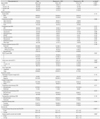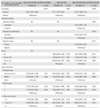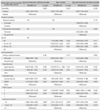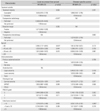Abstract
Background
Methods
Figures and Tables
 | Fig. 1Survival in the comorbid group was worse than that in the non-comorbid group. (A) Local recurrence-free survival. (B) Disease-specific survival. |
 | Fig. 2Comorbidity is suggested to have an independent prognostic effect on the survival of soft tissue sarcoma patients as well as confounding effects with certain poor prognostic factors. FNCLCC: the Federation Nationale des Centres de Lutte Contre le Cancer. |
Table 1
Patient Characteristics according to the Presence of Comorbidity

Values are presented as mean ± standard deviation or number (%).
UPS: undifferentiated pleomorphic sarcoma, MPNST: malignant peripheral nerve sheath tumor, DFSP: dermatofibrosarcoma protuberans, FNCLCC: the Federation Nationale des Centres de Lutte Contre le Cancer.
*Comparison between the groups with the presence and absence of comorbidity. †p-value < 0.05. ‡Incomplete treatment intensity refers to any of the following: (1) incomplete surgical margin, such as intralesional or marginal, during definitive surgery; (2) reduced or palliative dose or drop-out during first-line chemotherapy; and (3) palliative dose or drop-out during adjuvant and/or neoadjuvant radiotherapy.
Table 2
Multivariate Results for Local Recurrence-Free Survival

On univariate analysis, treatment intensity, postoperative radiotherapy, pathological resection margin, age, and histological types of synovial sarcoma and MPNST showed p-values < 0.10. With those variables, as well as the significantly related factors (age, synovial sarcoma, FNCLCC grade, and initial tumor size), multivariate analysis was performed. The presence of comorbidity showed a significantly poor prognostic effect for local recurrence-free survival, and remained significantly associated with the survival after adjusting for age and treatment variables.
HR: hazard ratio, CI: confidence interval, NA: not applied, MPNST: malignant peripheral nerve sheath tumor, FNCLCC: the Federation Nationale des Centres de Lutte Contre le Cancer.
*p-value < 0.05. †Incomplete treatment intensity means any of the following: (1) incomplete surgical margin, such as intralesional or marginal, during definitive surgery, (2) reduced or palliative dose or any drop-out during first-line chemotherapy, (3) palliative dose or any drop-out during adjuvant and/or neoadjuvant radiotherapy.
Table 3
Multivariate Results for Disease-Specific Survival

On univariate analysis, treatment intensity, postoperative chemotherapy, age, previous unplanned excision, anatomical site, histological type of MPNST, FNCLCC grade, and initial tumor size showed p-values < 0.10. With those variables, as well as the significantly related factors (age, synovial sarcoma, FNCLCC grade, and initial tumor size), multivariate analysis was performed. The presence of comorbidity showed a significantly poor prognostic effect for disease-specific survival, and remained significantly associated with the survival after adjusting for age and treatment variables.
HR: hazard ratio, CI: confidence interval, NA: not applied, MPNST: malignant peripheral nerve sheath tumor, FNCLCC: the Federation Nationale des Centres de Lutte Contre le Cancer.
*p-value < 0.05. †Incomplete treatment intensity means any of the following: (1) incomplete surgical margin, such as intralesional or marginal, during definitive surgery, (2) reduced or palliative dose or any drop-out during first-line chemotherapy, (3) palliative dose or any drop-out during adjuvant and/or neoadjuvant radiotherapy.
Table 4
Multivariate Results for Local Recurrence-Free Survival and Disease-Specific Survival When the Comorbidity was Excluded from the Co-Variables

On univariate analysis, the patient's age, which was of no prognostic value when the comorbidity was included in the analysis, showed significant prognostic value for local recurrence.
HR: hazard ratio, CI: confidence interval, NA: not applied, MPNST: malignant peripheral nerve sheath tumor, FNCLCC: the Federation Nationale des Centres de Lutte Contre le Cancer.
*p-value ≤ 0.05. †Incomplete treatment intensity means any of the following: (1) incomplete surgical margin, such as intralesional or marginal, during definitive surgery, (2) reduced or palliative dose or any drop-out during first-line chemotherapy, (3) palliative dose or any drop-out during adjuvant and/or neoadjuvant radiotherapy.




 PDF
PDF ePub
ePub Citation
Citation Print
Print


 XML Download
XML Download